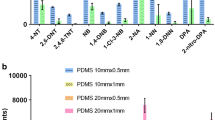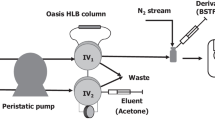Abstract
A new method using the extraction and preconcentration capabilities of stir bar sorptive extraction, combined with high-resolution gas chromatography and mass spectrometry, was developed for the determination of five selected endocrine-disrupting compounds (4-n-nonylphenol, bisphenol A, estrone, 17β-estradiol, and 17α-ethinylestradiol) in water. In situ derivatization to transform the phenolic compounds into lipophilic and volatile analytes was carried out with acetic anhydride. Two different methods of headspace derivatization to further improve the chromatographic properties of 17β-estradiol and 17α-ethinylestradiol were developed and compared. The optimized method provided good sensitivity (limits of quantitation 1.2–2.6 ng), repeatability (relative standard deviation 2–9%), and reproducibility (relative standard deviation 10–17%). Passive sampling by means of polar organic chemical integrative samplers was applied to monitor river waters used as supply sources for drinking water treatment plants in the Liguria region of Italy. The analytes showed a different distribution at the three sites considered; bisphenol A proved to be the most abundant, ranging from 185 to 459 ng per sampler.



Similar content being viewed by others
References
European Parliament and Council (2000) Off J Eur Communities L 327:1
European Parliament and Council (2006) COM(2006)397 final: proposal for a directive of the European Parliament and of the Council of 17 June 2006 on environmental quality standards in the field of water policy and amending Directive 2000/60/EC
Colborn T, Vom Saal FS, Soto AM (1993) Environ Health Perspect 101:378–384
European Commission (1996) European workshop on the impact of endocrine disrupters on human health and wildlife, vol 17549. Report of the proceedings, 2–4 December 1996. Weybridge, UK, p 125
European Commission (2001) European Commission report. Identification of priority hazardous substances. Stockholm Convention 2001. Adonis no 901019. European Commission, Brussels
Boyd GR, Reemtsma H, Grimm DA, Mitra S (2003) Sci Total Environ 311:135–149
Commission of the European Communities (1999) Community strategy for endocrine disrupters. COM 706. Commission of the European Communities, Brussels
Tan BLL, Hawker DW, Müller JF, Leusch FDL, Tremblay LA, Chapman HF (2007) Environ Int 33:654–669
Desbrow C, Routledge EJ, Brighty GC, Sumpter JP, Waldock M (1998) Environ Sci Technol 32:1549–1558
Diaz-Cruz MS, de Alda MJ Lopez, Lopez R, Barcelò D (2003) J Mass Spectrom 38:917–923
Vrana B, Allan IJ, Greenwood R, Mills GA, Dominiak E, Svensson K, Knutsson J, Morrison G (2005) Trends Anal Chem 24:845–868
Alvarez DA, Petty JD, Huckins JN, Jones-Lepp TL, Getting DT, Manahan SE (2004) Environ Toxicol Chem 23:1640–1648
Liscio C, Magi E, Di Carro M, Suter MJ-F, Vermeirssen ELM (2009) Environ Pollut 157:2716–2721
Lepom P, Hanke G, Wollgast J, Quevauviller P (eds) (2007) Guidance on surface water chemical monitoring under the Water Framework Directive. CIRCA Europa. http://circa.europa.eu/Public/irc/env/wfd/library
Baltussen E, Sandra P, David F, Cramers CJ (1999) Microcolumn Sep 11:737–747
Popp P, Bauer C, Hauser B, Keil P, Wennrich L (2003) J Sep Sci 26:961–967
Castro R, Natera R, Moreno MVG, Barroso CG (2002) J Chromatogr A 953:7–15
Buchholz KD, Pawliszyn J (1994) Anal Chem 66:160–167
Serodio P, Nogueira JMF (2005) Anal Bioanal Chem 382:1141–1151
Benijts T, Vercammen J, Dams R, Tuan HP, Lambert W, Sandra P (2001) J Chromatogr B 755:137–142
Connors KA, Albert KS (1973) J Pharm Sci 62:845–846
Rompa M, Kremer E, Zygmunt B (2003) Anal Bioanal Chem 377:590–599
Tienpont B, David F, Desmet K, Sandra P (2002) Anal Bioanal Chem 373:46–55
Balıkova M, Kohlıcek J (1989) J Chromatogr 497:159–167
Desmet K, Tienpont B, Sandra P (2003) Chromatographia 57:681–685
Ballesteros E, Gallego M, Valcarcel M (1990) J Chromatogr A 518:59–67
Bao ML, Pantani F, Barbieri K, Burrini D, Griffini O (1996) Chromatographia 42:227–233
Jahr D (1998) Chromatographia 47:49–56
Kawaguchi M, Ito R, Sakui N, Okanouchi N, Saito K, Nakazawa H (2006) J Chromatogr A 1105:140–147
Stopforth A, Burger BV, Crouch AM, Sandra P (2006) J Chromatogr B 834:134–140
Morgan E (1991) Chemometrics: experimental design. Wiley, Chichester, pp 197–256
Magi E, Liscio C, Di Carro M (2008) J Chromatogr A 1210:99–107
Morris V, Hughes J, Marriott P (2003) J Chromatogr A 1008:43–56
Derringer G, Suich R (1980) J Qual Technol 12:214–219
Lewis GA, Mathieu D, Phan-Tan-Luu R (1999) Pharmaceutical experimental design in drugs. Pharmaceutical science, vol 92. Dekker, New York, pp 247–248
Alvarez DA, Stackelberg PE, Petty JD, Huckings JN, Furlong ET, Zaugg SD, Meyer MT (2005) Chemosphere 61:610–622
Arditsoglou A, Voutsa D (2008) Environ Pollut 156:316–324
Rodriguez-Mozaz S, Lopez de Alda M, Barcelò D (2004) J Chromatogr A 1045:85–92
Ternes TA, Kreckel P, Mueller J (1999) Sci Total Environ 2225:91–99
Baronti C, Curini R, D’Ascenzo G, Di Corcia A, Gentili A, Saperi R (2000) Environ Sci Technol 34:5059–5066
Acknowledgements
This work was supported by a financial contribution from Fondazione AMGA Genova. The authors wish to thank Dr. Carlo Scapolla for his helpful scientific discussion. SRA Instruments srl (Milan, Italy) is acknowledged for providing the Gerstel multipurpose sampler with Twister® option.
Author information
Authors and Affiliations
Corresponding author
Rights and permissions
About this article
Cite this article
Magi, E., Di Carro, M. & Liscio, C. Passive sampling and stir bar sorptive extraction for the determination of endocrine-disrupting compounds in water by GC-MS. Anal Bioanal Chem 397, 1335–1345 (2010). https://doi.org/10.1007/s00216-010-3656-1
Received:
Revised:
Accepted:
Published:
Issue Date:
DOI: https://doi.org/10.1007/s00216-010-3656-1




